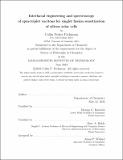Interfacial engineering and spectroscopy of spin-triplet excitons for singlet fission sensitization of silicon solar cells
Author(s)
Perkinson, Collin Fisher
DownloadThesis PDF (47.86Mb)
Advisor
Bawendi, Moungi G.
Baldo, Marc A.
Terms of use
Metadata
Show full item recordAbstract
Silicon solar cells account for 95% of global solar energy production today, but their power conversion efficiencies have improved by barely 2% in 25 years as they ap- proach their thermodynamic limit. Thermalization of high-energy photons is the single largest energy loss process in these devices, accounting for the loss of a third of all incident solar energy. Singlet exciton fission, an energy-splitting process that converts single high-energy photons into multiple lower-energy excited states, has the capability to reduce thermalization losses and boosts the maximum silicon solar cell efficiency from 29.4% (the Shockley-Queisser limit) to 35%.
While the idea of reducing heating losses in silicon solar cells using singlet fission has been circulating in the community for nearly half a century, the practical real- ization of such a device has yet to be demonstrated. In fact, despite many attempts, few studies have shown any evidence for energy transfer of spin-triplet excitons (the product states of singlet fission) to silicon. The challenge derives from the quantum mechanical spin properties of triplet excitons, resulting in triplets having vanishingly low ability to emit light, low mobility and small diffusion lengths, and requiring very close spacing with other materials to undergo energy transfer. This latter require- ment may be especially limiting for silicon, an indirect-bandgap semiconductor that requires carefully tailored chemical passivation layers to reduce energy trapping at its surface.
In this thesis, I employ interfacial engineering and spin-triplet spectroscopic tech- niques to explore three different approaches to singlet fission sensitization of silicon: radiative energy transfer, direct triplet transfer, and charge transfer. In the first approach, triplets are harvested by an interlayer containing heavy atoms, enabling the excited states to emit light that is subsequently absorbed by silicon. In the sec- ond approach, triplets transfer directly to silicon via short-range electron tunneling through a thin passivating interlayer. In the third approach, triplets are dissociated using an interlayer that facilitates charge transfer to silicon. In each case, particular attention is given to the materials between the singlet fission layer and silicon. These interlayers must be bifunctional, balancing triplet transfer to silicon with passivation of the silicon surface.
In my first project, we identify a need in the radiative energy transfer approach for higher-triplet-energy singlet fission materials. Through a high-throughput com- putational and experimental search, we discover two new singlet fission materials: dicyanoanthracene and difluorooctafluoroanthracene. These materials have triplet energies that could enable exothermic transfer to silicon via near infrared emitting quantum dots. In my second project, we find that subnanometer hafnium oxynitride enables efficient triplet transfer from the well-studied singlet fission material tetracene to silicon, possibly via direct triplet transfer. In my third project, finding evidence that triplet transfer via hafnium oxynitride is enabled by triplet dissociation with silicon, we investigate interlayers deliberately selected to facilitate charge transfer to silicon; and we show that zinc phthalocyanine enables charge-transfer-mediated sin- glet fission sensitization of silicon. In the final project of this thesis, I explore the potential of singlet fission materials for magnetic field sensing, showing that they can be used for spatial imaging of magnetic fields, as well as to create a first-of-its-kind magnetic field switchable singlet fission laser.
The studies in this thesis advance our understanding of the mechanisms of triplet energy transfer to silicon, expand the range of applications for singlet fission, and present interfacial engineering strategies and spectroscopic probes for triplet excitons. I hope that these findings will benefit ongoing efforts to realize efficient singlet fission sensitization of silicon and help to one day push commercial solar cells beyond their conventional thermodynamic limits.
Date issued
2023-06Department
Massachusetts Institute of Technology. Department of ChemistryPublisher
Massachusetts Institute of Technology